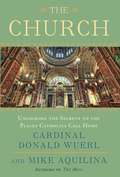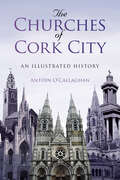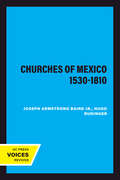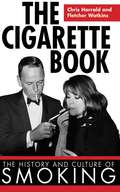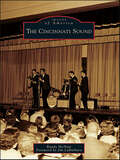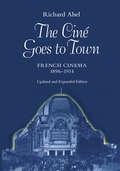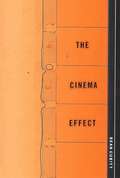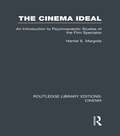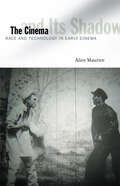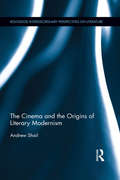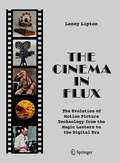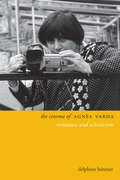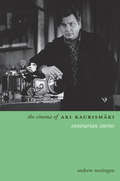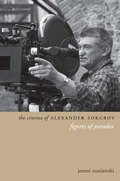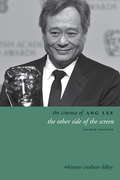- Table View
- List View
The Church: Unlocking the Secrets to the Places Catholics Call Home
by Mike Aquilina Cardinal Donald WuerlFrom the bestselling authors of The Mass, an insightful and practical guide that explores the architectural and spiritual components of the Catholic Church.Your local church is not only a physical place, but a spiritual home. In this through-provoking book, Wuerl and Aquilina illuminate the importance of the Church in its many guises and examine the theological ideas behind the physical structure of churches, cathedrals, and basilicas. How is a church designed? What is the function of the altar? What does the nave represent? What is the significance of the choir loft? With eloquent prose and elegant black-and-white photography, these questions and many more will lead to answers that illuminate the history and practicality of Catholic life.
The Churches of Cork City: An Illustrated History
by Antoin O'CallaghanThe churches, chapels and meetings houses of Cork are the bedrock of the city. They represent the finest of architecture; house some of our most treasured art and their development mirrors and records the growth of the city itself. A comprehensive and accessible guide for locals, tourists and historians, this work provides a fascinating insight into the wider history of Cork for well over a thousand years.
The Churches of Mexico 1530-1810
by Joseph Armstrong Baird Jr.This title is part of UC Press's Voices Revived program, which commemorates University of California Press’s mission to seek out and cultivate the brightest minds and give them voice, reach, and impact. Drawing on a backlist dating to 1893, Voices Revived makes high-quality, peer-reviewed scholarship accessible once again using print-on-demand technology. This title was originally published in 1962.
The Cigarette Book: The History and Culture of Smoking
by Fletcher Watkins Chris HarraldFrom A is for Aardvark--"We're not allowed to tell you anything about Winston cigarettes, so here's a stuffed aardvark"--to Z is for Zippo, the iconic American lighter, The Cigarette Book is the ultimate souvenir and celebration of the dying art of smoking. Encyclopedic in both layout and range, this is an ideal consolation gift for those who have stopped, an ideal aide de memoire for those who might, and a defiant puff of libertarian brilliance for those who won't. Celebrate the Hollywood age of smoking when film stars lit up with glamorous abandon. Witty, illustrated, collectible, and up-to-date. "... All smokers know that cigarettes are dangerous. Each one is a dance with death--and the defiant smoker will say that therein lies its charm. So each puff is an existential gesture, an assertion of choice and life in the face of death." One day the last cigarette on earth will be smoked. One final puff will be sent heaven-bound, leaving a lingering, evanescent smoke ring. And the wise of this world will rejoice. Because logic demands that mankind is rid of this pernicious poison. And wasn't that well-known logician Adolf Hitler the most virulent opponent of cigarette smoking in the last century? Until then, read this book.
The Cincinnati Sound (Images of America)
by Randy McNuttFrom 1940 to 1970, Cincinnati overflowed with musical opportunities. Hank Williams recorded his hit "Lovesick Blues." Andy Williams, Rosemary andBetty Clooney, and Doris Day appeared regularly on WLW Radio, which also broadcast Boone County Jamboree. Then came the network television showMidwestern Hayride and stardom for Kenny Price. Meanwhile, King and Fraternity Records released hundreds of hits for James Brown, Hank Ballard and the Midnighters, Cowboy Copas, Lonnie Mack, and the Casinos. In the late 1960s, the Lemon Pipers sang "Green Tambourine," and rock bands ruled Coney Island's Moonlite Gardens. It was a wild, incredible ride while it lasted, and it left such an indelible impression that today Cincinnati is remembered as one of America's top music capitals.
The Cine Goes to Town: French Cinema, 1896-1914, Updated and Expanded Edition
by Richard AbelRichard Abel's magisterial new book radically rewrites the history of French cinema between 1896 and 1914, particularly during the years when Pathé-Frères, the first major corporation in the new industry, led the world in film production and distribution. Based on extensive investigation of rare archival films and documents, and drawing on recent social and cultural histories of turn-of-the-century France and the United States, his book provides new insights into the earliest history of the cinema.Abel tells how early French film entertainment changed from a cinema of attractions to the narrative format that Hollywood would so successfully exploit. He describes the popular genres of the era—comic chases, trick films and féeries, historical and biblical stories, family melodramas and grand guignol tales, crime and detective films—and shows the shift from short subjects to feature-length films. Cinema venues evolved along with the films as live music, color effects, and other new exhibiting techniques and practices drew larger and larger audiences. Abel explores the ways these early films mapped significant differences in French social life, helping to produce thoroughly bourgeois citizens for Third Republic France.The Ciné Goes to Town recovers early French cinema's unique contribution to the development of the mass culture industry. As the one-hundredth anniversary of cinema approaches, this compelling demonstration of film's role in the formation of social and national identity will attract a wide audience of film scholars, social and cultural historians, and film enthusiasts.
The Cinema Effect
by Sean CubittIn this highly original examination of time in film, Sean Cubitt tries to get at the root of the uncanny effect produced by images and sounds that don't quite align with reality.
The Cinema Ideal: An Introduction to Psychoanalytic Studies of the Film Spectator (Routledge Library Editions: Cinema)
by Harriet E. MargolisThis study explores the model derived from Freudian and Lacanian psychoanalysis, via Marxism and semiotics, of looking at film. It retraces the steps of film theory from ideological criticism of the late ‘60s to spectator studies in 1988 when the book was originally published. Psychoanalysis enables a discussion of the cinema’s role as a social and political force and this book enters a discourse of the politics of representation. Reconstructing discussion of basic issues, the book addresses our instincts and defences in reacting to cinema, the similarity between mental processes and cinematic technique, narrative techniques and the ‘cinematic apparatus’. Importantly, the book concerns itself with the concept of ideology and how the filmviewing experience engages the spectator in a complex net of stimuli presenting representations of an ideal world and the effect of this within film studies.
The Cinema and Its Shadow: Race and Technology in Early Cinema
by Alice MauriceThe Cinema and Its Shadow argues that race has defined the cinematic apparatus since the earliest motion pictures, especially at times of technological transition. In particular, this work explores how racial difference became central to the resolving of cinematic problems: the stationary camera, narrative form, realism, the synchronization of image and sound, and, perhaps most fundamentally, the immaterial image—the cinema&’s &“shadow,&” which figures both the material reality of the screen image and its racist past. Discussing early &“race subjects,&” Alice Maurice demonstrates that these films influenced cinematic narrative in lasting ways by helping to determine the relation between stillness and motion, spectacle and narrative drive. The book examines how motion picture technology related to race, embodiment, and authenticity at specific junctures in cinema&’s development, including the advent of narratives, feature films, and sound. In close readings of such films as The Cheat, Shadows, and Hallelujah!, Maurice reveals how the rhetoric of race repeatedly embodies film technology, endowing it with a powerful mix of authenticity and magic. In this way, the racialized subject became the perfect medium for showing off, shoring up, and reintroducing the cinematic apparatus at various points in the history of American film. Moving beyond analyzing race in purely thematic or ideological terms, Maurice traces how it shaped the formal and technological means of the cinema.
The Cinema and the Origins of Literary Modernism (Routledge Interdisciplinary Perspectives on Literature)
by Andrew ShailModernist writing has always been linked with cinema. The recent renaissance in early British film studies has allowed cinema to emerge as a major historical context for literary practice. Treating cinema as a historical rather than an aesthetic influence, this book analyzes the role of early British film culture in literature, thus providing the first account of cinema as a cause for modernism. Shail’s study draws on little-known sources to create a detailed picture of cinema following its ‘second birth’ as both institution and medium. The book presents a comprehensive account of how UK-based modernism originated as a consequence of—rather than a conscious aesthetic response to—this new component of the cultural landscape. Film’s new accounts of language, endeavor, time, collectivity and political change are first considered, then related to the patterns that comprised modernist texts. Authors discussed include Ford Madox Ford, Joseph Conrad, Wyndham Lewis, Ezra Pound, H.D., James Joyce, Virginia Woolf and Dorothy Richardson.
The Cinema in Flux: The Evolution of Motion Picture Technology from the Magic Lantern to the Digital Era
by Lenny LiptonThe first of its kind, this book traces the evolution of motion picture technology in its entirety. Beginning with Huygens' magic lantern and ending in the current electronic era, it explains cinema’s scientific foundations and the development of parallel enabling technologies alongside the lives of the innovators. Product development issues, business and marketplace factors, the interaction of aesthetic and technological demands, and the patent system all play key roles in the tale. The topics are covered sequentially, with detailed discussion of the transition from the magic lantern to Edison’s invention of the 35mm camera, the development of the celluloid cinema, and the transition from celluloid to digital. Unique and essential reading from a lifetime innovator in the field of cinema technology, this engaging and well-illustrated book will appeal to anyone interested in the history and science of cinema, from movie buffs to academics and members of the motion picture industry.
The Cinema of Agnès Varda
by Delphine BenezetAgnès Varda, a pioneer of the French New Wave, has been making radical films for over half a century. Many of these are considered by scholars, filmmakers, and audiences alike, as audacious, seminal, and unforgettable. This volme considers her production as a whole, revisiting overlooked films like Mur, Murs/Documenteur (1980--81), and connecting her cinema to recent installation work. This study demonstrates how Varda has resisted norms of representation and diktats of production. It also shows how she has elaborated a personal repertoire of images, characters, and settings, which all provide insight on their cultural and political contexts. The book thus offers new readings of this director's multifaceted rêveries, arguing that her work should be seen as an aesthetically influential and ethically-driven production where cinema is both a political and collaborative practice, and a synesthetic art form.
The Cinema of Agnès Varda: Resistance and Eclecticism (Directors' Cuts)
by Delphine BenezetAgnès Varda, a pioneer of the French New Wave, has been making radical films for over half a century. Many of these are considered by scholars, filmmakers, and audiences alike, as audacious, seminal, and unforgettable. This volume considers her production as a whole, revisiting overlooked films like Mur, Murs/Documenteur (1980–81), and connecting her cinema to recent installation work. This study demonstrates how Varda has resisted norms of representation and diktats of production. It also shows how she has elaborated a personal repertoire of images, characters, and settings, which all provide insight on their cultural and political contexts. The book thus offers new readings of this director's multifaceted rêveries, arguing that her work should be seen as an aesthetically influential and ethically-driven production where cinema is both a political and collaborative practice, and a synesthetic art form.
The Cinema of Aki Kaurismäki: Contrarian Stories
by Andrew NestingenAki Kaurismäki is an enigma, an eminent auteur who claims his films are a joke. Since 1983, Kaurismäki has produced classically-styled films filled with cinephilic references to film history. He has earned an international art-house audience and many prizes, influencing such directors as Jim Jarmusch, Quentin Tarantino, and Wes Anderson. Yet Kaurismäki is often depicted as the loneliest, most nostalgic of Finns (except when he promotes his films, makes political statements, and runs his many businesses). He is also depicted as a bohemian known for outlandish actions and statements. The Cinema of Aki Kaurismäki is the first comprehensive English-language study of this eccentric director. Drawing on revisionist approaches to film authorship, the text links the filmmaker and his films to the stories and issues animating film aesthetics and history, nostalgia, late modernity, politics, commerce, film festivals, and national cinema.
The Cinema of Aki Kaurismäki: Contrarian Stories (Directors' Cuts)
by Andrew NestingenAki Kaurismäki is an enigma, an eminent auteur who claims his films are a joke. Since 1983, Kaurismäki has produced classically-styled films filled with cinephilic references to film history. He has earned an international art-house audience and many prizes, influencing such directors as Jim Jarmusch, Quentin Tarantino, and Wes Anderson. Yet Kaurismäki is often depicted as the loneliest, most nostalgic of Finns (except when he promotes his films, makes political statements, and runs his many businesses). He is also depicted as a bohemian known for outlandish actions and statements. The Cinema of Aki Kaurismäki is the first comprehensive English-language study of this eccentric director. Drawing on revisionist approaches to film authorship, the text links the filmmaker and his films to the stories and issues animating film aesthetics and history, nostalgia, late modernity, politics, commerce, film festivals, and national cinema.
The Cinema of Alexander Sokurov: Figures of Paradox
by Jeremi SzaniawskiOne of the last representatives of a brand of serious, high-art cinema, Alexander Sokurov has produced a massive oeuvre exploring issues such as history, power, memory, kinship, death, the human soul, and the responsibility of the artist. Through contextualization and close readings of each of his feature fiction films (broaching many of his documentaries in the process), this volume unearths a vision of Sokurov's films as equally mournful and passionate, intellectual, and sensual, and also identifies in them a powerful, if discursively repressed, queer sensitivity, alongside a pattern of tensions and paradoxes. This book thus offers new keys to understand the lasting and ever-renewed appeal of the Russian director's Janus-like and surprisingly dynamic cinema -- a deeply original and complex body of work in dialogue with the past, the present and the future.
The Cinema of Alexander Sokurov: Figures of Paradox (Directors' Cuts)
by Jeremi SzaniawskiOne of the last representatives of a brand of serious, high-art cinema, Alexander Sokurov has produced a massive oeuvre exploring issues such as history, power, memory, kinship, death, the human soul, and the responsibility of the artist. Through contextualization and close readings of each of his feature fiction films (broaching many of his documentaries in the process), this volume unearths a vision of Sokurov's films as equally mournful and passionate, intellectual, and sensual, and also identifies in them a powerful, if discursively repressed, queer sensitivity, alongside a pattern of tensions and paradoxes. This book thus offers new keys to understand the lasting and ever-renewed appeal of the Russian director's Janus-like and surprisingly dynamic cinema – a deeply original and complex body of work in dialogue with the past, the present and the future.
The Cinema of Ang Lee
by Whitney Crothers DilleySuggestive readings of gender and identity explore the international appeal of Ang Lee
The Cinema of Ang Lee
by Whitney Crothers DilleySuggestive readings of gender and identity explore the international appeal of Ang Lee
The Cinema of Ang Lee: The Other Side of the Screen (Directors' Cuts)
by Whitney Crothers DilleyBorn in Taiwan, Ang Lee is one of cinema's most versatile and daring directors. His ability to cut across cultural, national, and sexual boundaries has given him recognition in all corners of the world, the ability to work with complete artistic freedom whether inside or outside of Hollywood, and two Academy Awards for Best Director. He has won astounding critical acclaim for Crouching Tiger, Hidden Dragon (2000), which transformed the status of martial arts films across the globe, Brokeback Mountain (2005), which challenged the reception and presentation of homosexuality in mainstream cinema, and Life of Pi (2012), Lee's first use of groundbreaking 3D technology and his first foray into complex spiritual themes.In this volume, the only full-length study of Lee's work, Whitney Crothers Dilley analyzes all of his career to date: Lee's early Chinese trilogy films (including The Wedding Banquet, 1993, and Eat Drink Man Woman, 1994), period drama (Sense and Sensibility, 1995), martial arts (Crouching Tiger, Hidden Dragon, 2000), blockbusters (Hulk, 2003), and intimate portraits of wartime psychology, from the Confederate side of the Civil War (Ride with the Devil, 1999) to Japanese-occupied Shanghai (Lust/Caution, 2007). Dilley examines Lee's favored themes such as father/son relationships and intergenerational conflict in The Ice Storm (1997) and Taking Woodstock (2009). By looking at the beginnings of Lee's career, Dilley positions the filmmaker's work within the roots of the Taiwan New Cinema movement, as well as the larger context of world cinema. Using suggestive readings of both gender and identity, this new study not only provides a valuable academic resource but also an enjoyable read that uncovers the enormous appeal of this acclaimed director.
The Cinema of Ang Lee: The Other Side of the Screen, second edition
by Dilley Whitney CrothersSuggestive readings of gender and identity explore the international appeal of Ang Lee
The Cinema of Apartheid: Race and Class in South African Film (Routledge Library Editions: Cinema)
by Keyan TomaselliThis study analyses the historical development of South African cinema up to he book's original publication in 1988. It describes the films and comments on their relationship to South African realities, addressing all aspects of the industry, focusing on domestic production, but also discussing international film companies who use South Africa as a location. It explores tensions between English-language and Afrikaans-language films, and between films made for blacks and films made for whites. Going behind the scenes the author looks at the financial infrastructure, the marketing strategies, and the works habits of the film industry. He concludes with a discussion of independent filmmaking, the obstacles facing South Africans who want to make films with artistic and political integrity, and the possibilities of progress in the future. Includes comprehensive bibliography and filmography listing all feature films made in South Africa between 1910 and 1985 together with documentary films by South Africans, non-South Africans, and exiles about the country.
The Cinema of Barbara Stanwyck: Twenty-Six Short Essays on a Working Star (Women’s Media History Now!)
by Catherine RussellFrom The Lady Eve, to The Big Valley, Barbara Stanwyck played parts that showcased her multidimensional talents but also illustrated the limits imposed on women in film and television. Catherine Russell’s A to Z consideration of the iconic actress analyzes twenty-six facets of Stanwyck and the America of her times. Russell examines Stanwyck’s work onscreen against the backdrop of costuming and other aspects of filmmaking. But she also views the actress’s off-screen performance within the Hollywood networks that made her an industry favorite and longtime cornerstone of the entertainment community. Russell’s montage approach coalesces into an engrossing portrait of a singular artist whose intelligence and savvy placed her center-stage in the production of her films and in the debates around women, femininity, and motherhood that roiled mid-century America. Original and rich, The Cinema of Barbara Stanwyck is an essential and entertaining reexamination of an enduring Hollywood star.
The Cinema of Béla Tarr: The Circle Closes
by András Bálint KovácsThe Cinema of Béla Tarr is a critical analysis of the work of Hungary's most prominent and internationally best known film director,
The Cinema of Béla Tarr: The Circle Closes (Directors' Cuts)
by András KovácsThe Cinema of Béla Tarr is a critical analysis of the work of Hungary's most prominent and internationally best known film director, written by a scholar who has followed Bela Tarr's career through a close personal and professional relationship for more than twenty-five years. András Bálint Kovács traces the development of Tarr's themes, characters, and style, showing that almost all of his major stylistic and narrative innovations were already present in his early films and that through a conscious and meticulous recombination of and experimentation with these elements, Tarr arrived at his unique style. The significance of these films is that, beyond their aesthetic and historical value, they provide the most powerful vision of an entire region and its historical situation. Tarr's films express, in their universalistic language, the shared feelings of millions of Eastern Europeans.
